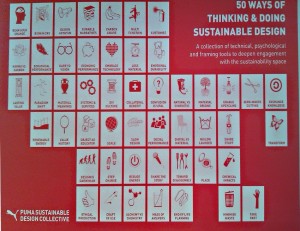 This article is the first of a series of 2, which looks at what Puma has achieved within the realm of their sustainability initiatives. This first instalment looks at the general initiatives of Puma in this area, while the second instalment will look at concrete results that have been achieved.
This article is the first of a series of 2, which looks at what Puma has achieved within the realm of their sustainability initiatives. This first instalment looks at the general initiatives of Puma in this area, while the second instalment will look at concrete results that have been achieved.
Background
Puma’s executive have recognised some while ago that their company’s profitability and resilience to competition depends not the least on how well they are able to foresee risks in an area normally just referred to as ‘sustainability’. With this term any aspect with regards to their environmental and social performance, or impact, is denominated – all of which of course not only have an impact on society and the planet, but certainly also on their own bottom line.
In the past few years the company has hence introduced several tools as well as initiatives that aimed at introducing sustainable design principles into their company. Some of them apply to the company as a whole, others are but trialled and tested in their London hub.
All of them however have as a clear focus the following key aspects:
– Assess a baseline – identify aspects in their business processes that can be remedied immediately, generating not only substantial environmental benefits, but also safe money at the same time.
– Give their designers initial insights into the methods and methodologies that are available to them to ask the right questions, and make their designs ‘perform’ better.
– Make their results public by engaging with the ‘right’ public in dependence of their results and their own future in-house needs.
Project Outcomes
– PUMA’s own Restricted Substances List which relates to dye stuffs, treatment and finishing chemicals
– 2 new package designs (clever little bag, and “I’m only half the bag I used to be”.
– Puma Sustainable Design Collective event series.
– Environmental Profit & Loss accounts for the company as a whole
– Environmental Profit & Loss accounts by product line (to come, date unknown).
– Social Profit & Loss accounts for the company as a whole (to come, 2015 as been informally mentioned as initial target date for launch publication).
Puma’s Challenges
The European commission on energy stated that
“It is estimated that over 80% of all product-related environmental impacts are determined during the design phase of a product.”
The same, in essence, applies also to the cost incurred in producing a product. We know that in the present it is still difficult to estimate in cash-equivalent value of the environmental impact of design decisions. But, on the other hand, we also know that the financial bottom line is directly impacted in more than a single way by the exactly same design decisions. As a consequence, there is in the end no other way than measuring environmental impacts and their current and potential future impact on the financial balance sheets, provided we want to make sure that a company remains in the financial benefit zone for decades to come.
It is hence Puma’s priority to be aware of what their products impacts are. By reducing the impact on the environment through better design, this will likely also reduce costs – and the other way around, provided it all is done at the design stage.
More specifically hence, the challenge is about how to introduce ‘better design habits’ into their designer departments.
Puma’s Actions and Initiatives
In their analysis – possibly for what would later become the Environmental Profit and Loss accounts – it became apparent that shipping their goods half around the world from the manufacturing countries to retail was both, cost intensive as well as the highest contributor to their carbon footprint.
With a detailed Life Cycle Assessment, packaging was proven to have the largest single impact because
– tighter packaging means less space for shipping and hence lower carbon footprint per product, but equally importantly, saves money
– packaging material is both, relatively expensive, and far from ideal for its environmental impact, notably once discarded.

Design being the key problem, the company also approached Dr. Jonathan Chapman from the University of Brighton to work with them to find strategic and creative approaches that embed sustainability more centrally within their design process.
From this process resulted 50 different approaches on how to view, practise and think about sustainable design (graphic right), and a series of 4 lectures, intended as the starting point of a dialogue, and entitled the ‘Puma Sustainable Design Collective‘, to which London’s sustainable design professionals were invited.
Upcoming: Tangible Outcomes as of Summer 2012
—
This article is the first of a series of 2, which looks at what Puma has achieved within the realm of their sustainability initiatives. This first instalment looks at the general initiatives of Puma in this area, while the second instalment will look at concrete results that have been achieved.

